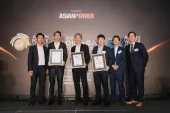
Balancing technology will be key to achieving net-zero targets in Southeast Asia
Wärtsilä talks about how renewables combined with flexible balancing technologies will enable net-zero power systems in the region.
Achieving emission reduction targets in Southeast Asia has been a prime concern of its nations for many years now. With the effects of climate change being felt across the globe, finding ways to mitigate it continues to be a primary concern, not just for leaders, but for businesses and industries as well.
At the recently concluded Enlit Asia 2022 held at the Bangkok International Trade & Exhibition Centre (BITEC), Asian Power had the opportunity to interview Wärtsilä Energy’s President and Executive Vice President, Sushil Purohit, and discuss the energy transition in Southeast Asia.
When asked about how feasible it will be for countries within the Southeast Asian region to commit to their net-zero targets, Purohit said that it is not a distant dream, hinting at its plausibility.
“We recently published a “Rethinking Energy in Southeast Asia” report that looks at cost-optimal paths to net-zero power systems in three Southeast Asian countries: Vietnam, the Philippines, and Indonesia. The key finding of the report is that achieving net-zero is not a distant dream and it is not going to be more expensive than the power system cost that we currently have. The steps that we need to take across the region are going to be similar,” he said.
Purohit said that it is necessary to rapidly increase the number of renewables to become the main source of energy. Then, alongside that, adding flexible balancing capacity will be crucial.
“When we talk about balancing technology, we are talking about two things: energy storage, which provides minute-to-hour balancing of the power systems, sometimes also load shifting; and grid balancing engine power plants, which provide balancing on an hourly, daily, weekly, and seasonal basis. Both these technologies, together with renewables, can actually provide an optimal pathway to net-zero.”
The Wärtsilä Energy President emphasised that committing to increasing renewable energy sources isn’t enough. They have to be paired with flexible technology to balance intermittency and ensure backup power is available when there is insufficient wind or solar.
To do this, Purohit said that having policy interventions will be crucial in laying out long-term plans to achieve a carbon-neutral future. Policy interventions are needed to incentivise flexibility and the integration of renewable energy in Southeast Asia.
“What is important to note is that we need policy interventions to incentivise flexibility and the integration of renewable energy. We need to reward flexibility because flexible technology can enable energy transition rapidly and optimally,” he added.
Based on Wärtsilä’s “Rethinking Energy in Southeast Asia” report and power system modellings, Purohit said that the region needs to phase out inflexible capacity and the priority should be to phase out coal. The final push to reach a net-zero power system requires the production of sustainable fuels such as green hydrogen, which will become a primary fuel for running balancing engine power plants.
Through their power system modelling, Wärtsilä found that the Philippines could achieve net-zero by 2050, and by doing so, the country could reduce power costs by 23% by 2040.
At the same time, Vietnam could achieve net-zero by 2050 and cut 20% of its power system costs, which is equivalent to US$28B per annum.
Meanwhile, Indonesia could achieve net-zero by 2060 and cut its power system costs by 23% and save US$19B per annum.
“If we look at the recent climate events that we have had globally, from freezing in Texas, flooding in Germany, to high temperatures in April in Asia, it is quite clear that the climate is changing. What we need to do is to make sure that we start to build a future-proof power system going forward."
“We also see that net-zero commitments are starting to emerge worldwide, also in Southeast Asia. Both Vietnam and Indonesia have now declared that they will not invest in any new coal plants after 2030, only already planned and committed coal power plants will be built. In addition, it is becoming increasingly difficult to get financing for new coal power plants. As more renewables are added to the system, both demand and reliance on coal will decrease,” he added.



















 Advertise
Advertise






